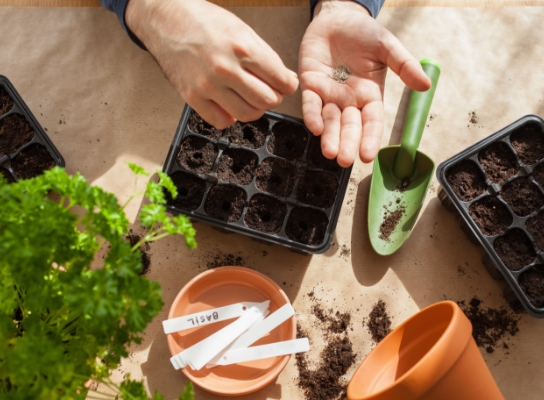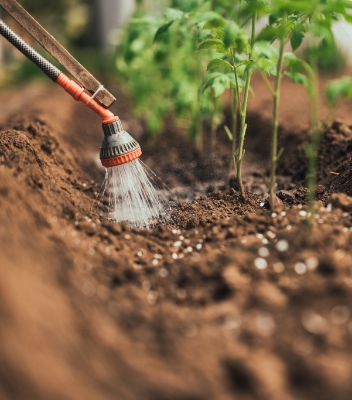
How to create your own
urban garden
4 minute read
Urban gardening has become very popular over the past few years. With so many of us becoming more curious and conscious about where our food comes from, urban gardening is a great way to reconnect with nature, utilize your balcony or backyard area and contribute to building a cleaner world.
What is urban gardening?
What comes to mind when you think of urban gardening? A garden on top of a high rise in a big city? An above-ground planter on an apartment balcony full of tomatoes and kale? A city community garden planted by kids at a local high school? A garden in your backyard? Urban gardening is all of these things and there are so many different ways to get involved.
Urban gardening is great for your well-being. It helps you to reconnect with nature, which reduces stress and brings families and neighbors together. It reduces the carbon footprint or "food miles" of transporting fruits and vegetables and it can help you save some money on your weekly grocery shop.
What is urban farming?
Urban farming is similar to urban gardening just on a slightly larger scale. With the population of cities increasing all the time, urban farming has sprung up in cities worldwide to provide food to underserved communities, meet the growing demand for local food to reduce the impact on the environment. Today, urban farmers are producing vegetables, fruit, and other food and even raising animals in urban environments.
Cities like Tokyo, Singapore, and Hong Kong are at the cutting edge of urban farming. And in big cities in the US like Los Angeles and New York, urban gardening is helping communities to make better use of underutilized spaces. In some cities, you can now find urban farms on office building roofs, railway tracks, and even underused parking lots. Urban and community-led gardens are also helping to alleviate food insecurity, especially in the city of Detroit, which has over 1,400 urban gardens.
Today, more than 800 million people are engaged in
urban agriculture worldwide.
FOOD AND AGRICULTURE ORGANISATION (FAO)
How to get started with urban gardening
Everyone can start an urban garden. You can use your balcony space, your windowsill, or talk to others in your building about transforming part of your shared garden or outdoor space into a shared garden. You’ll be surprised how much you can grow in small spaces! Here’s how to get started.
Step 1: Create a space
Whether you choose a sunny patch on your balcony, part of your shared rooftop garden, an alleyway, or a plot of land close to your house, the first step in starting your urban garden is to choose your space. If your chosen space is owned by your building or city authority then you also need to get the necessary permission to start gardening there. Once you’ve done that, you need to measure how much space you’ve got and decide how big you want your garden to be – this will help you decide how many pots or raised beds you need.
Step 2: Pick your pots
The next step is to choose how to grow your plants. While decorative pots can be pretty, they don't improve the quality of your plants and can be very expensive. Instead, you can use a large bucket from a garden store or opt for raised beds which you can either buy or construct yourself. You can also get creative and upcycle containers such as crates, old toys, or paint cans.
Top Tip: Take your plants vertical
A great option for making the most of your tiny balcony or backyard space is vertical gardening. You can use stack planters, railing planters, vertical wall planters, and hanging baskets for an amazing urban garden.
Step 3: Pick your plants
When it comes to picking your plants, you should look out for vegetable, flower, and herb varieties that are easy to grow in urban spaces. When planning your garden, think about what to plant where – shallow-rooted veggies, such as herbs, lettuce, and radishes typically do better in confined spaces. Some plants may also need more sunlight, and some may need more shade.
5 perfect veggies to grow
in your urban garden
1) Peppers
2) Beans
3) Salad Greens
4) Tomatoes
5) Peas
Step 4: Sow your seeds or pot your plants
Choose whether you want to start with seedlings or plants. If you decide to start with seeds, then you can start growing them in old egg cartons or plant pots on your windowsill. If you choose to start with plants, then you’ll have to repot them. Potting your plants is easy. Put some gravel in the bottom of your container to help with drainage, pull your plant out of its plastic pot holding the roots and put it into the pot roots down. Then, fill the pot with soil, tamp it down and water gently. Leave around 1 inch at the top for watering.


Step 5: Water your garden regularly
The most important step for keeping your urban garden alive is to water your plants regularly. If you have the space and want some help with this, then it’s worth looking at some of the advanced watering systems on the market that will keep your plants hydrated. But whether you choose a watering system or a watering can, make sure to water your plants a couple of times a week.
Here at Hyundai, we’re committed to building a world that is fit for Generation One – the first generation to live in an emissions-free world. To do this, we’re in progress to becoming carbon neutral. We’re also involved in several environmental initiatives around the world like our ongoing partnership with Healthy Seas which is involved in ocean clean-ups. We’ve also planted our own IONIQ forest on Sinsido island and we’re using recycled materials inside our IONIQ cars.
Feeling inspired to start your own urban garden? Follow Hyundai’s Instagram(@hyundai) to find out more about how we’re building a world fit for Generation One.